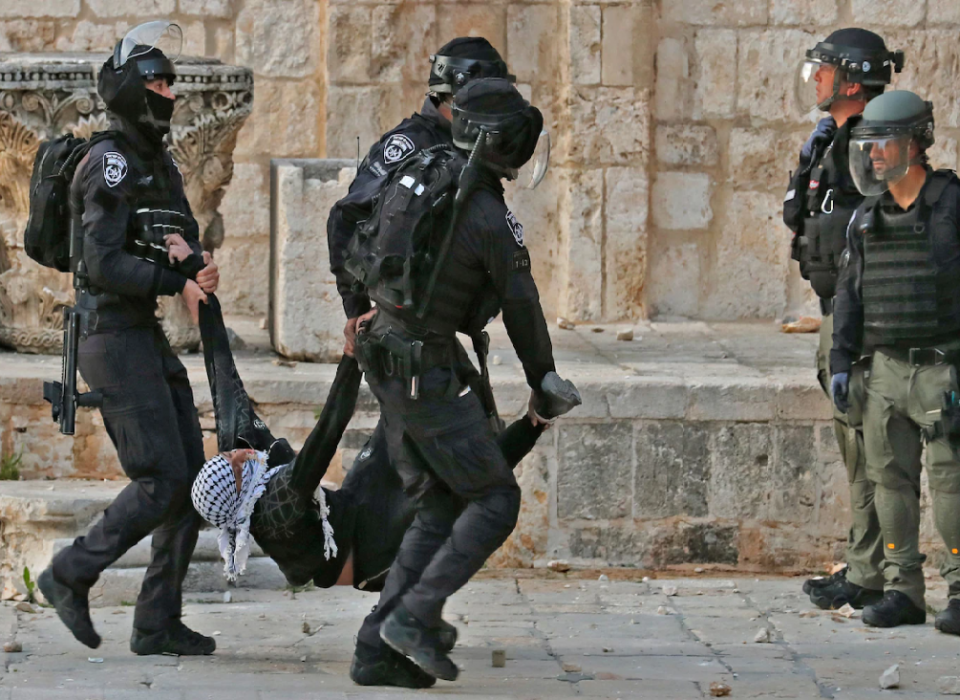Common Grounds
Opinion | How media coverage whitewashes Israeli state violence against Palestinians
Source: The Washington Post
By Laura Albast and Cat Knarr
Published April 28, 2022

Israeli police carry a wounded Palestinian demonstrator outside Jerusalem's Al-Aqsa mosque compound on April 22. (Ahmad Gharabli/AFP/Getty Images)
At the break of dawn on April 15, Israeli police attacked Palestinian worshipers at the holy site of Al-Aqsa mosque in Jerusalem. They used stun grenades, tear gas and rubber-coated steel bullets, wounding more than 150. Since then, Israeli forces have launched new incursions, detaining more than 300 Palestinians at the Al-Aqsa compound and blocking Palestinian Christians from entering the Church of the Holy Sepulchre. This carefully calculated violence comes as Palestinian Muslims enter the last days of Ramadan.
When looking at the footage of what happened, the dynamic is obvious: forces with gear and guns versus worshipers kneeling in prayer. However, Western media coverage routinely labels this situation as “complicated,” portraying this state violence as “clashes” and “tensions” between two sides. Headlines in outlets such as the Associated Press, the New York Times, the Guardian, the Wall Street Journal, NBC News and others use language that fails to recognize the power imbalance between the Israeli military apparatus and the native Palestinian people.
This is a pattern we have seen over and over again in media coverage of Palestine. Palestinians are not killed; we simply die. When Israeli forces raid our neighborhoods in the middle of the night, bomb our children, demolish our homes, colonize our land and kill our people, we are somehow equal instigators. Media descriptions regularly imply a false symmetry between occupier and occupied, propping up anti-Palestinian and Islamophobic narratives that blame the Palestinian people for Israeli aggression.
This contrasts with coverage of the war in Ukraine, in which the Western media makes it very clear that Russia is the aggressor and the Ukrainian people are resisting, as any person would if their home were to be invaded. From calling for sanctions on Moscow to praising the use of Molotov cocktails against Russian soldiers in Kyiv, major Western outlets have supported the Ukrainian population’s attempts to defend themselves.
Yet, when it comes to the Israeli occupation of Palestine, these same outlets often fail to name the aggressor at all. Ukrainian civilians throwing Molotov cocktails at Russian tanks are called “brave,” but 14-year-old Qusai Hamamrah was depicted as posing an immediate threat after armed Israeli soldiers claimed he threw a Molotov cocktail at them. This marks a stark, racist difference in coverage, which glazed over eyewitness accounts that the boy was running to hide from Israeli bullets aimed at another Palestinian.
Newsrooms cannot pick and choose which state-sanctioned violence is legitimate. They must make an effort to report the actions of the Israeli military and Israeli settlers in the same way that abuses in Ukraine and other countries are covered. Indeed, the Israeli government is very aware of the media’s potential to expose these abuses. Israeli forces bombed press offices in the Gaza Strip last May and have attacked journalists such as Nasreen Salem at Al-Aqsa.
Last summer, more than 500 journalists signed an open letter calling out harmful malpractice in U.S. media coverage of Palestine. The outcry was not heard; biased coverage continues to be the norm.
This month, the Arab and Middle Eastern Journalists Association reminded reporters to be mindful of language and context and reshared reporting guidance issued during Israel’s deadly onslaught against Gaza last year, which killed 259 Palestinians, including 66 children. The guidance asks that reporters recognize that Palestinians are subjected to an unjust and unequal system, which has been documented as apartheid by international organizations such as Human Rights Watch and Amnesty International, as well as the Israeli human rights organization B’Tselem. It also asked reporters to be wary of religious framing and to “tell readers who was killed or injured, where and by whom, using active rather than passive language.” What this means, in practice, is making clear who the aggressor is, what action they took and who it was against.
Journalists have a responsibility to report facts without bias. Journalism is about people: their stories, their history, their reality. This includes the Palestinian people. Factual reporting must include seeking Palestinian voices and investigating claims by government officials before reporting them as truth.
By neglecting to contextualize Israeli state violence, the media has given the Israeli government a free pass, enabling it to continue ethnically cleansing the Palestinian people with impunity. It is time for outlets to address the harm they have done. They should make an effort to hire Palestinian journalists and center Palestinian voices, instead of consistently erasing them from their own stories. The endless footage of documented violence against Palestinians should not remain confined to social media feeds (which face a different form of censorship).
Instead of conveying incomplete narratives that give reign to Israeli aggression, the media must start telling the full story.
Laura Albast, a Palestinian American journalist and translator, is senior editor of digital strategy and communications at the Institute for Palestine Studies-USA. Cat Knarr, a writer of Palestinian and Colombian descent, is the communications director at the U.S. Campaign for Palestinian Rights.
LATEST OPEN LETTERS
-
21-07Freedom
-
20-03Stand up to Trump
-
18-02Average Americans Response
-
23-12Tens of thousands of dead children.......this must stop
-
05-06A Call to Action: Uniting for a Lasting Peace in the Holy Land
-
28-05Concerned world citizen
-
13-02World Peace
-
05-12My scream to the world
-
16-11To Syria and Bashar al-Assad
-
16-11To Palestine
VIRTUAL POST OFFICE
PETITIONS
LINKS
DONATION
Latest Blog Articles
-
25-12Our Friday News Analysis | What the World Reads Now!
-
24-12Our Wednesday News Analysis | Why Palestinians face the same fate, weapons or not
-
23-12Why Palestinians face the same fate, weapons or not
-
23-12Western elites fear a ‘globalised intifada’ because they are its targets, not Jews
-
23-12A smaller cage: Israel’s ‘two-state solution’ on Gaza’s ruins
-
22-12The Evangelical Pope | A Humane Future Before God
-
17-12Our Wednesday News Analysis | Gaza and the unravelling of a world order built on power
-
16-12Gaza and the unravelling of a world order built on power
-
16-12US plan in Gaza: forced ghettoisation, annexation, mass detention, resource plunder
-
16-12Von der Leyen and Blair still want to boss Palestinians around
-
15-12The Evangelical Pope | The Universal Value of Life
Latest Comments
 One of the most important and illuminating articles that I …
One of the most important and illuminating articles that I …
Comment by Benjamin Inbaraj And what's wrong here?
After all, there is the homeland …
And what's wrong here?
After all, there is the homeland …
Comment by Isac Boian Does this reinforce or deny my argument that Israel is …
Does this reinforce or deny my argument that Israel is …
Comment by Edward Campbell Many 'say' they support the Palestinian cause but do little …
Many 'say' they support the Palestinian cause but do little …
Comment by Philip McFedries The UN is strangled by the "war for profit" cabal …
The UN is strangled by the "war for profit" cabal …
Comment by Philip McFedries I can't read the printing on the map.
I can't read the printing on the map.
Comment by Philip McFedries Good news!
Good news!
Comment by Philip McFedries

COMMENTS
This article has 0 comments at this time. We invoke you to participate the discussion and leave your comment below. Share your opinion and let the world know.